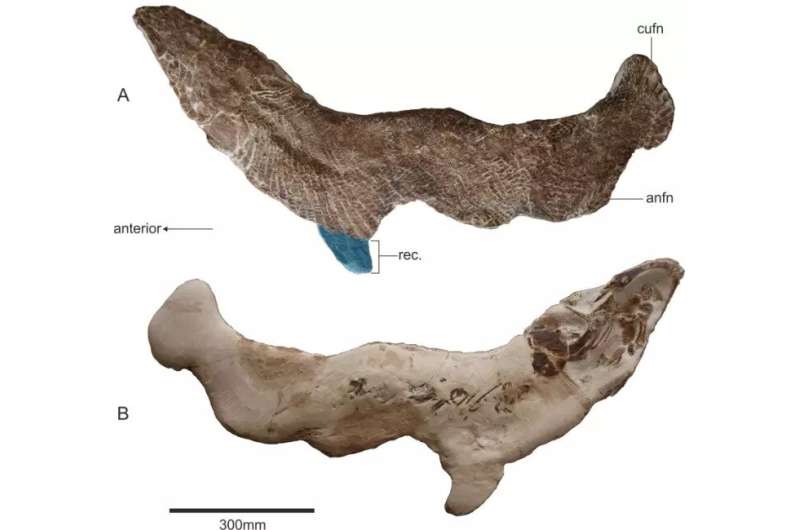This article has been reviewed according to Science X's editorial process and policies. Editors have highlighted the following attributes while ensuring the content's credibility:
fact-checked
peer-reviewed publication
trusted source
proofread
New discovery unveils the ancient marine origins of gar fish

A new species of ancient gar fish that thrived in a marine environment 66 million years ago has been identified by an international team of paleontologists.
The meter-long fossil is the first complete specimen described from a Cretaceous marine deposit, which provides compelling evidence that gars were likely to be fully marine fishes during the Late Jurassic period.
The discovery supports the idea that gars may have originated in the sea and later adapted to freshwater habitats, offering invaluable insights into their evolutionary history.
The new species Grandemarinus gherisensis is described in the paper "A new fully marine, short-snouted lepisosteid gar from the Upper Cretaceous (Turonian) of North Africa," published in Cretaceous Research. It is named after leading American ichthyologist Lance Grande who has studied garfish evolution for most of his life.
One of the paper's authors, Professor David Martill, from the University of Portsmouth, said, "This new species challenges our understanding of gars as predominantly freshwater dwellers and sheds light on their remarkable ability to adapt to different environments. It's an extraordinary finding as partial or mostly complete specimens are exceedingly rare."
The fossil, originally from a Saharan oasis at the foot of the Atlas Mountains called Asfla, in Morocco, was discovered by an undergraduate paleontology student who spotted it online for sale. Both he and Martill were keen to repatriate it to its original home.
Martill added, "It's an impressive fossil, which is one meter long with fins, scales and a big head. We wanted to save it for science so it didn't just end up on someone's mantelpiece, while also ensuring it will safely remain within the future heritage of Morocco."
The specimen has been donated to the Department of Geology, Hassan II University of Casablanca.
Gar fish usually have an elongated snout and rows of sharp, needle-like teeth, which are suited for catching smaller fish and insects. This particular specimen has an unusually short snout compared to the length of its head.
The shape of its head is likely related to its hunting style. The short robust jaw could crush hard-bodied prey such as crabs and small turtles.
The specimen also has a "fake fin," which had been glued on.
Martill said, "This fin is likely a construction by the original preparator to make the fish appear more 'complete' before being sold. The rest of the specimen is undoubtedly original."
A team of researchers from across the globe employed cutting-edge techniques in paleontological analysis and phylogenetic reconstruction to investigate the early evolution of gars.
Sam Cooper from the University of Hohenheim in Germany collaborated with Paulo M. Brito from Rio de Janeiro State University, Brazil, Samir Zouhri from Hassan II University of Casablanca, Morocco and David Martill and James Gunn from the University of Portsmouth in the U.K.
Cooper said, "Discovery of a complete garfish in a deep water marine environment is exceptional, and highly unexpected, particularly given that all living gars are confided to fresh and brackish water environments, mostly hiding out in rivers and lakes around northern and central America.
"We have now identified at least three specimens of this new gar, one of which is a juvenile on account of its smaller size and incompletely fused skull roof. This is exciting because it demonstrates that both juveniles and adults were living alongside each other in the open seaway.
"We patiently anticipate the discovery of additional marine gar specimens, which would help us build a more comprehensive understanding about the early evolution and distribution of gar fishes during the Cretaceous."
More information: Samuel L.A. Cooper et al, A new fully marine, short-snouted lepisosteid gar from the Upper Cretaceous (Turonian) of North Africa, Cretaceous Research (2023). DOI: 10.1016/j.cretres.2023.105650
Journal information: Cretaceous Research
Provided by University of Portsmouth





















